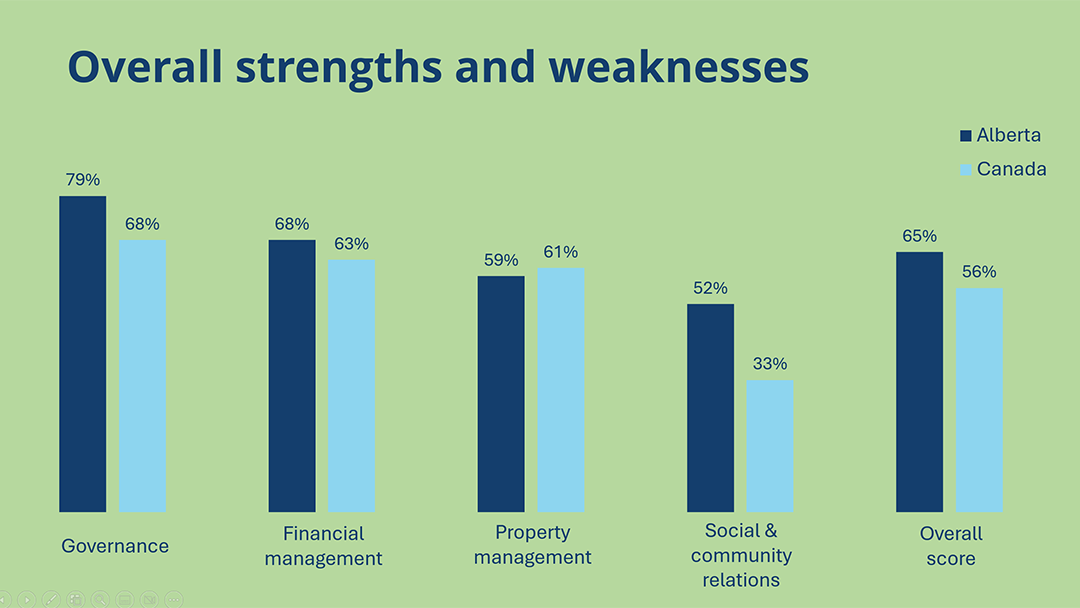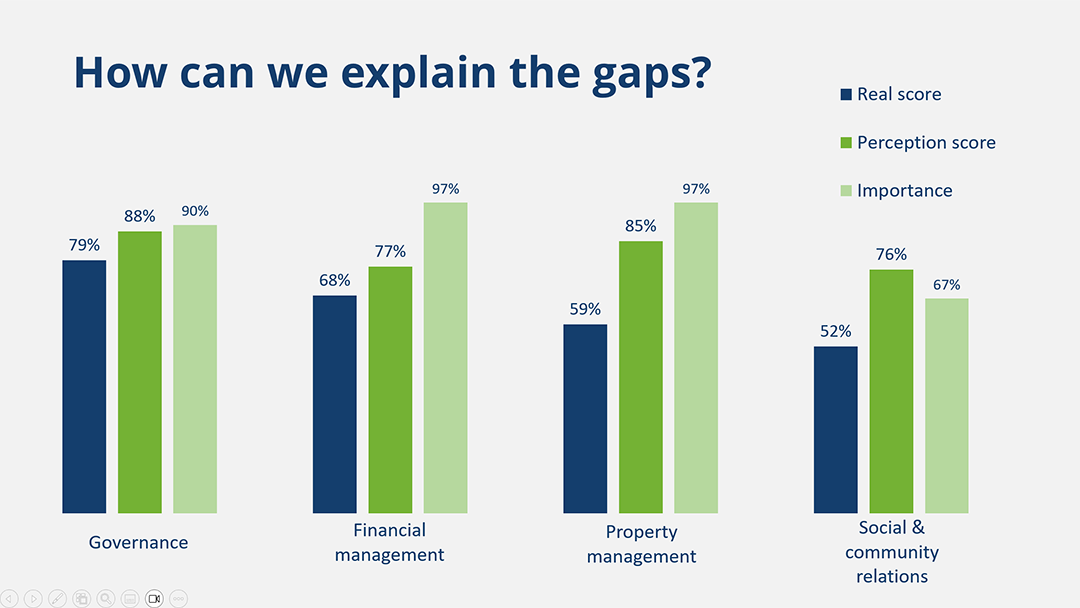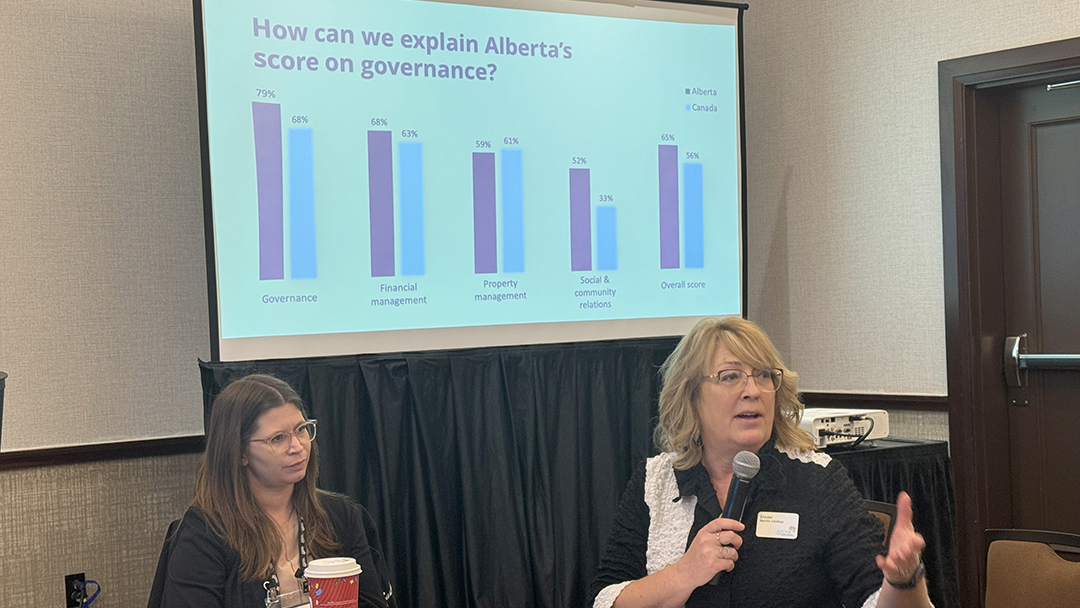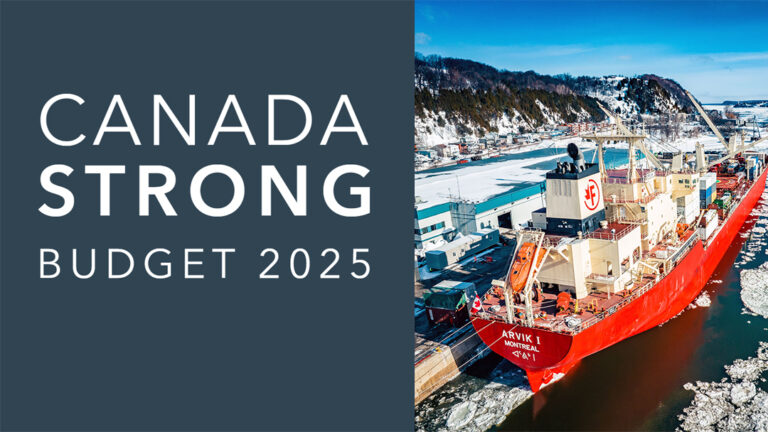In the spring of 2024, the Centre invited members of the Alberta Seniors & Community Housing Association (ASCHA) to evaluate their organizations using the Organizational Compass. This exercise was not only useful for the individual members, but it also led to the aggregation of collected data, allowing for the identification of trends within the group. The results were presented at ASCHA’s conference in March. The following analysis revisits these findings, aiming to explore the strengths and areas for capacity development of the participating organizations.
The Organizational Compass: a framework for measuring and enhancing community housing impact
The Organizational Compass is a strategic tool that assists community housing organizations in evaluating and strengthening their impact by analyzing key aspects of governance, financial management, property management, and community engagement. It identifies strengths and areas for improvement, providing a framework for sustainable development tailored to community needs. The aggregated data from the Compass reveal common trends and provide insights to inform public policy and encourage more strategic sector development.
This report is based on data from 15 community housing organizations in Alberta. Since this group represents only 19% of ASCHA’s community housing provider members, the data is not statistically representative of all members. Nevertheless, presenting this analysis to a hundred housing providers during the March 2024 workshop sparked both animated conversation and the sharing of experiences among participants. This case study serves as a valuable reflection tool for Albertans and potentially for the broader Canadian context.
Strengths and challenges of participating organizations
The group’s results highlight solid practices in governance and property management while revealing significant challenges in financial management and community relations.

Governance: structural soundness and diversity challenges
Governance stands out as the strongest category among the 15 organizations, with structured practices and a high level of compliance. However, aspects such as inclusivity and diversity require improvement to enhance the resilience of these organizations.
Strengths:
- Well-established governance practices: organizations demonstrate rigor in governance practices. Approximately 91% of boards meet regularly, review financial statements, and comply with legal obligations, ensuring enhanced transparency and accountability.
- Diverse skills on boards: the majority of boards include members with a variety of skills, such as management, accounting, law, and social work. This diversity enables boards to address complex challenges in an informed and holistic manner.
- Compliance with legal obligations: nearly 98% ensure regulatory compliance, contributing to professional management and reduced legal risk.
Areas for capacity building:
- Tenant diversity and inclusion: board composition remains limited in diversity, both in terms of tenant representation and cultural diversity. Only 4% include tenants on their boards, restricting resident voices in decision-making.
- Training and succession programs: although 61% of boards have training and succession planning programs, increasing this capacity will ensure continuity and skill building among leadership teams.
- Transparency with tenants and stakeholders: communication between boards and tenants is limited, which may reduce tenant engagement and understanding of board decisions.
Governance overview
The group’s performance can be partly attributed to continued support from ASCHA. Alberta’s provincial policies, such as the “Stronger Foundations” plan, which encourages structured governance and improved organizational management, also played a role in these results.
The governance analysis shows a balance between rigor and structural limitations. While boards demonstrate rigor and diverse skills, they still need to do work on inclusivity and tenant representation. Additionally, strong legal compliance does not always translate into transparency with residents, potentially leading to tensions. Finally, despite a range of skills, the absence of training and succession programs limits boards’ adaptability to future challenges. A more inclusive and transparent governance structure, supported by continuous training, would be beneficial.
Financial management: relative stability, dependency, and long-term challenges
Financial management is a critical area for organizational stability. While several group members demonstrate good financial stability at present, vulnerabilities did emerge, particularly regarding long-term sustainability.
Strengths:
- Low rent arrears rate: approximately 84% report minimal rent arrears, reflecting effective rent management and the ability to maintain steady income, which is essential for financial stability.
- Eviction prevention strategies: nearly 67% have implemented eviction prevention policies, which protect vulnerable tenants and support continuity of income for the organization.
- Efficiency in reducing operating costs: Several organizations have adopted practices to reduce operating costs (e.g., energy efficiency and resource management). This proactive approach helps preserve financial resources while ensuring a comfortable living environment for tenants.
Areas for capacity building:
- Grants: Around 67% indicate that their current rents are viable only due to grants. This dependency creates a precarious financial situation, making them vulnerable if grants are reduced or removed.
- Post-agreement viability plans: Only 30% have developed a plan for the end of their funding agreements, limiting their ability to anticipate and manage long-term financial risks.
- Capital reserves: Only 41% have sufficient reserves to fund planned renovations, representing a risk, as uncovered maintenance needs could deteriorate infrastructure, impacting residents’ quality of life.
Financial management overview
The analysis reveals a vicious cycle: dependence on grants prevents building sufficient reserves, which, in turn, increases reliance on external funding to remain operational.
While current financial practices provide stability for tenants, the absence of long-term capital asset management plans, for example, exposes the group to significant risks. A reduction in grants could force these organizations to cut services or raise rents, affecting the outcomes associated with their mission. Although operating costs are reduced through efficiency measures, this does not offset the lack of funds dedicated to capital work. Unforeseen issues could compromise the quality and safety of the housing provided.
In summary, implementing financial viability strategies is essential to sustain the social impact of these organizations and reduce dependency on grants.
Property management: responsiveness to immediate needs and long-term vulnerability
Property management is an area where these 15 organizations show generally satisfactory performance. However, gaps in regular building assessments and capital replacement reserves reveal risks to service quality and durability.
Strengths:
- Responsiveness to tenant requests: About 93% are effective in responding to tenant requests, particularly in repairs and maintenance, contributing to residents’ well-being and satisfaction with their living environment.
- Proactive preventive maintenance: Approximately 67% adopt preventive maintenance strategies, reducing emergency repair costs and extending the lifespan of buildings. These practices help maintain infrastructure and prevent major structural issues.
- Good building condition: About 73% report that their buildings are in good condition, reflecting good property management and a commitment to providing safe and comfortable housing.
Area for capacity building:
- Regular building assessments: Only 23% of properties have recently undergone a comprehensive building condition assessment. The absence of such assessments could lead to unawareness of critical maintenance needs, posing risks to resident safety and quality of life.
- Contributions to capital replacement funds: Approximately 43% report irregular contributions to their capital replacement funds, exposing them to financial difficulties in case of emergency repairs.
- Grants: Many depend on grants to cover maintenance costs, which could limit their ability to maintain adequate levels of care if grants are reduced or removed.
Property management overview
Property management demonstrates strong responsiveness to tenants’ daily needs, with preventive maintenance practices and generally well-maintained buildings. However, structural weaknesses remain: the absence of regular assessments exposes organizations to unanticipated maintenance needs, while irregular replacement funds and dependence on grants weaken their ability to ensure long-term durability. To strengthen their assets, establishing regular contributions to replacement funds, conducting periodic assessments, and diversifying funding sources will improve outcomes.
Social and community relations: occasional involvement, lack of sustainable integration
Social and community relations emerge as the area with the greatest need for improvement among the four groups. Despite efforts to encourage community engagement, low tenant participation in decision-making and insufficient diversity in activities limit the impact of these initiatives.
Strengths:
- Tenant participation in community Events: About 66% report active tenant participation in community events and shared spaces, fostering connections and a sense of community.
- Recognition of economic and racial diversity: The group acknowledges diversity, particularly economic (37%) and racial (40%), showing sensitivity to tenants’ realities, though further efforts are needed to involve these groups in decisions.
- Use of community services and spaces: Between 52% and 79% of tenants use community services and spaces, contributing to an integrated social environment and fostering social cohesion.
Areas for capacity building:
- Tenant participation in governance: Only 4% include tenants on their boards, and only 19% of tenants participate in decision-making processes. This lack of representation limits opportunities for residents to actively shape decisions impacting their living environment.
- Resident engagement in long-term initiatives: While tenants participate in community events, their involvement in sustainable projects remains limited. This lack of sustained engagement hinders the development of strong social ties and restricts constructive feedback to improve community services.
- Social relations: Compared to other categories, social and community relations are perceived as a lower priority by some organizations, which may explain lower scores in this area. This could limit efforts to strengthen tenants’ sense of belonging.
Social and community relations overview
The group makes efforts to foster social inclusion through community events and shared spaces. However, while tenants are active in these activities, their involvement in governance remains marginal, with only 4% participation on boards of directors, for example. This limits their capacity to influence decisions that directly affect their daily lives. The recognition of economic and cultural diversity is present but has yet to translate into sustainable initiatives promoting continuous engagement. Increasing the focus on social relations and integrating tenants into governance would be beneficial.
Toward greater resilience: enhancing strengths and addressing challenges for lasting impact
In summary, the Organizational Compass analysis highlights solid strengths on which this group can build and notable challenges that need addressing to ensure a more sustainable future for their organizations.

Governance and property management practices stand out for their rigor and daily effectiveness but reveal structural weaknesses, particularly in inclusivity, diversity, and long-term sustainability. In financial management, dependency on grants exposes organizations to risks, emphasizing the need for viability strategies and revenue diversification. Finally, social and community relations, though present, remain underdeveloped in their potential for inclusion and sustainable engagement.
By strengthening these areas, organizations will be better equipped to meet their residents’ needs while ensuring resilience and long-term impact.
Test your organization’s performance with the Organizational Compass here.








